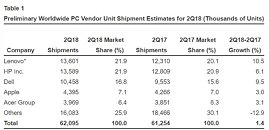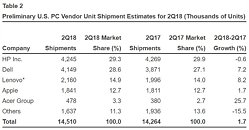- Joined
- Oct 9, 2007
- Messages
- 47,447 (7.50/day)
- Location
- Hyderabad, India
| System Name | RBMK-1000 |
|---|---|
| Processor | AMD Ryzen 7 5700G |
| Motherboard | ASUS ROG Strix B450-E Gaming |
| Cooling | DeepCool Gammax L240 V2 |
| Memory | 2x 8GB G.Skill Sniper X |
| Video Card(s) | Palit GeForce RTX 2080 SUPER GameRock |
| Storage | Western Digital Black NVMe 512GB |
| Display(s) | BenQ 1440p 60 Hz 27-inch |
| Case | Corsair Carbide 100R |
| Audio Device(s) | ASUS SupremeFX S1220A |
| Power Supply | Cooler Master MWE Gold 650W |
| Mouse | ASUS ROG Strix Impact |
| Keyboard | Gamdias Hermes E2 |
| Software | Windows 11 Pro |
Worldwide PC shipments totaled 62.1 million units in the second quarter of 2018, a 1.4 percent increase from the second quarter of 2017, according to preliminary results by Gartner, Inc. This is the first quarter of year-over-year global PC shipment growth since the first quarter of 2012.
All regions experienced some growth compared with a year ago. While the results are a positive result for the PC industry, Gartner analysts said this sign of market stability is not enough to declare a PC industry recovery just yet.
"PC shipment growth in the second quarter of 2018 was driven by demand in the business market, which was offset by declining shipments in the consumer segment," said Mikako Kitagawa, principal analyst at Gartner. "In the consumer space, the fundamental market structure, due to changes on PC user behavior, still remains, and continues to impact market growth. Consumers are using their smartphones for even more daily tasks, such as checking social media, calendaring, banking and shopping, which is reducing the need for a consumer PC.
"In the business segment, PC momentum will weaken in two years when the replacement peak for Windows 10 passes. PC vendors should look for ways to maintain growth in the business market as the Windows 10 upgrade cycle tails off."
With the completion of Lenovo's joint venture with Fujitsu, three out of four PCs were shipped by the top five PC vendors in the second quarter of 2018. With the inclusion of Fujitsu's PC shipments due to the joint venture (a formation of Joint Venture with Fujitsu), Lenovo was in a virtual tie with HP Inc. for the top spot in the second quarter of 2018 based on global PC shipments (see Table 1). All of the top five PC vendors experienced an increase in worldwide PC shipments in the quarter.

Notes: Data includes desk-based PCs, notebook PCs and ultramobile premiums (such as Microsoft Surface), but not Chromebooks or iPads. All data is estimated based on a preliminary study. Final estimates will be subject to change. The statistics are based on shipments selling into channels. Numbers may not add up to totals shown due to rounding.
Lenovo's results include Fujitsu's units starting in 2Q18 to reflect the joint venture that closed in May 2018.
Source: Gartner (July 2018)
HP Inc. had its third consecutive quarter of year-over-year PC shipment growth. HP Inc. maintained steady growth across all regions, except the U.S. In the other regions, its shipment growth well exceeded the regional averages. Lenovo experienced its highest growth rate since the first quarter of 2015.
While Dell's competitors have shown PC shipment declines periodically in the past two years, Dell's shipments did not decline during this time because of its strong focus on growth areas, especially in the commercial segment, as well as cutting off unprofitable businesses.
In the U.S. PC market, the industry returned to growth after six consecutive quarters of shipment declines. In the second quarter of 2018, U.S. PC shipments totaled 14.5 million units, a 1.7 percent increase from the same period last year (see Table 2). HP Inc. continued to be the market leader in the U.S., but Dell closed the gap, as Dell's U.S. PC shipments increased 7.2 percent.
"In the U.S., business PC demand was particularly strong among the public sector as the second quarter is typically PC buying season among government and education buyers," Ms. Kitagawa said. "Desk-based PC growth was attributed to continued high usage of desk-based PCs in the U.S. public sectors. Mobile PCs grew in the U.S., but strong Chromebook demand in the education market adversely affected PC growth. Overall, Chromebooks grew 8 percent in the U.S., but Chromebooks are not included in the PC market statistics."

Notes: Data includes desk-based PCs, notebook PCs and ultramobile premiums (such as Microsoft Surface), but not Chromebooks or iPads. All data is estimated based on a preliminary study. Final estimates will be subject to change. The statistics are based on shipments selling into channels. Numbers may not add up to totals shown due to rounding.
Lenovo's results include Fujitsu's units starting in 2Q18 to reflect the joint venture that closed in May 2018.
Source: Gartner (July 2018)
PC shipments in EMEA reached 17.4 million units in the second quarter of 2018, a 1.3 percent increase year over year. In Western Europe, demand was strong for business PCs in Germany and the U.K. Eurasia, which includes Russia, remained the growth region in EMEA. While the second quarter is usually a slower quarter in terms of PC demand, several countries, such as Russia, Ukraine and Kazakhstan, continued to see increasing consumer demand.
PC shipments in Asia/Pacific totaled 21.3 million units, a 0.1 percent increase from the second quarter of 2017. India, Indonesia, Thailand and other emerging markets in Asia showed improvement in the commercial segment due to demand for replacing aging PCs and upgrading to Windows 10. In China, PC shipments declined 3.6 percent year over year as some business procurements have been postponed to 2019, and the consumer market is saturated.
These results are preliminary. Final statistics will be available soon to clients of Gartner's PC Quarterly Statistics Worldwide by Region program. This program offers a comprehensive and timely picture of the worldwide PC market, allowing product planning, distribution, marketing and sales organizations to keep abreast of key issues and their future implications around the globe.
View at TechPowerUp Main Site
All regions experienced some growth compared with a year ago. While the results are a positive result for the PC industry, Gartner analysts said this sign of market stability is not enough to declare a PC industry recovery just yet.
"PC shipment growth in the second quarter of 2018 was driven by demand in the business market, which was offset by declining shipments in the consumer segment," said Mikako Kitagawa, principal analyst at Gartner. "In the consumer space, the fundamental market structure, due to changes on PC user behavior, still remains, and continues to impact market growth. Consumers are using their smartphones for even more daily tasks, such as checking social media, calendaring, banking and shopping, which is reducing the need for a consumer PC.
"In the business segment, PC momentum will weaken in two years when the replacement peak for Windows 10 passes. PC vendors should look for ways to maintain growth in the business market as the Windows 10 upgrade cycle tails off."
With the completion of Lenovo's joint venture with Fujitsu, three out of four PCs were shipped by the top five PC vendors in the second quarter of 2018. With the inclusion of Fujitsu's PC shipments due to the joint venture (a formation of Joint Venture with Fujitsu), Lenovo was in a virtual tie with HP Inc. for the top spot in the second quarter of 2018 based on global PC shipments (see Table 1). All of the top five PC vendors experienced an increase in worldwide PC shipments in the quarter.

Notes: Data includes desk-based PCs, notebook PCs and ultramobile premiums (such as Microsoft Surface), but not Chromebooks or iPads. All data is estimated based on a preliminary study. Final estimates will be subject to change. The statistics are based on shipments selling into channels. Numbers may not add up to totals shown due to rounding.
Lenovo's results include Fujitsu's units starting in 2Q18 to reflect the joint venture that closed in May 2018.
Source: Gartner (July 2018)
HP Inc. had its third consecutive quarter of year-over-year PC shipment growth. HP Inc. maintained steady growth across all regions, except the U.S. In the other regions, its shipment growth well exceeded the regional averages. Lenovo experienced its highest growth rate since the first quarter of 2015.
While Dell's competitors have shown PC shipment declines periodically in the past two years, Dell's shipments did not decline during this time because of its strong focus on growth areas, especially in the commercial segment, as well as cutting off unprofitable businesses.
In the U.S. PC market, the industry returned to growth after six consecutive quarters of shipment declines. In the second quarter of 2018, U.S. PC shipments totaled 14.5 million units, a 1.7 percent increase from the same period last year (see Table 2). HP Inc. continued to be the market leader in the U.S., but Dell closed the gap, as Dell's U.S. PC shipments increased 7.2 percent.
"In the U.S., business PC demand was particularly strong among the public sector as the second quarter is typically PC buying season among government and education buyers," Ms. Kitagawa said. "Desk-based PC growth was attributed to continued high usage of desk-based PCs in the U.S. public sectors. Mobile PCs grew in the U.S., but strong Chromebook demand in the education market adversely affected PC growth. Overall, Chromebooks grew 8 percent in the U.S., but Chromebooks are not included in the PC market statistics."

Notes: Data includes desk-based PCs, notebook PCs and ultramobile premiums (such as Microsoft Surface), but not Chromebooks or iPads. All data is estimated based on a preliminary study. Final estimates will be subject to change. The statistics are based on shipments selling into channels. Numbers may not add up to totals shown due to rounding.
Lenovo's results include Fujitsu's units starting in 2Q18 to reflect the joint venture that closed in May 2018.
Source: Gartner (July 2018)
PC shipments in EMEA reached 17.4 million units in the second quarter of 2018, a 1.3 percent increase year over year. In Western Europe, demand was strong for business PCs in Germany and the U.K. Eurasia, which includes Russia, remained the growth region in EMEA. While the second quarter is usually a slower quarter in terms of PC demand, several countries, such as Russia, Ukraine and Kazakhstan, continued to see increasing consumer demand.
PC shipments in Asia/Pacific totaled 21.3 million units, a 0.1 percent increase from the second quarter of 2017. India, Indonesia, Thailand and other emerging markets in Asia showed improvement in the commercial segment due to demand for replacing aging PCs and upgrading to Windows 10. In China, PC shipments declined 3.6 percent year over year as some business procurements have been postponed to 2019, and the consumer market is saturated.
These results are preliminary. Final statistics will be available soon to clients of Gartner's PC Quarterly Statistics Worldwide by Region program. This program offers a comprehensive and timely picture of the worldwide PC market, allowing product planning, distribution, marketing and sales organizations to keep abreast of key issues and their future implications around the globe.
View at TechPowerUp Main Site




